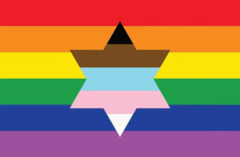A Part of Something Bigger….
11/01/2022 09:30:04 AM

As I stand in front of the open ark in our sanctuary with an upcoming B’nai Mitzvah student, one of the first things I often ask them is if they’ve ever really paid attention to how many sifrei Torah (Torah Scrolls) are in the ark. At a quick glance, it’s clear that there are five scrolls sitting regally in our Aron HaKodesh. The truth is, there’s no prescribed number of scrolls for the ark. In fact, according to tradition, all we know is that when possible, there should be more than one. That’s it. The idea here is that the Torah should never be left unaccompanied.
Why then, might the designers of this particular ark have decided upon the number five? Most B’nai Mitzvah students hem and haw when I ask this question, not realizing that they more than likely really do know the answer to this one. The number five corresponds to the number of books in the Torah, in fact, it’s often referred to as the Five Books of Moses. I’d imagine that the designers of our ark chose to have space for five Torah scrolls to symbolically represent those five sacred books, just as the designers of my previous congregation had space for seven Torah scrolls, harkening to the biblical Creation Story.
Often, students will follow up this new knowledge with a question of their own, “Does that mean that each scroll has something different in it?” The answer is no. However, what makes each scroll unique is similar to what makes every human unique. We are all essentially the same on the inside. Our primary differences, of course, are physical and external. So too, with Torah scrolls. They all say the same thing on the inside and they are all written with more or less the same “font.” What differentiates each scroll is that some are larger, use heavier wood and have really clear and legible print, while others may have writing (all done by hand by a professional scribe known as a sofer) that’s smaller and more challenging to decipher.
The scroll that the majority of our B’nai Mitzvah chant from is one that I sometimes refer to as the “Goldilocks” of scrolls. It has the best balance of how heavy it is to carry with how easy it is to read. In other words, it’s “just right!”
While the practical reason we use this particular scroll is interesting, what’s even more significant is the spiritual explanation for using this scroll. Holding the “Goldilocks Torah,” our B’nai Mitzvah are connected in a very real and powerful way to all of the kids who’ve come before them at our temple…some of whom they know (friends, siblings, sometimes parents) and most of whom, they don’t know. It also connects them very palpably to all of the community members who were involved in the commissioning and writing of the scroll back in 2005. It also connects them to all of the future B’nai Mitzvah at our temple who will hold and chant from the exact same Torah scroll, on the exact same bimah.
So, on the one hand, becoming a Bat Mitzvah might feel as though it’s all about “me.” All these people coming to see “me.” All these eyes staring at “me.” All of this pressure is on “me.” But on the other hand, it’s not about “me” at all. After all, there was most likely a Bar Mitzvah the week before, and usually there will be another one the next week. And there will be one across town at our neighboring temple, and there will be one in New York City and Mexico City too. Becoming a B’nai Mitzvah is just something that Jewish kids do. Becoming a B’nai Mitzvah is about recognizing that there’s something much bigger than yourself out there, and now as a more fully recognized member of the Jewish community, you are a part of that.
One of my favorite teachings from Reb. Simcha Bunim of Pschichka (say that ten times fast) says that we are each to go through life as though we have a piece of paper in each pocket. In one pocket, the piece of paper says “The world was created just for me” while the paper in the other pocket says “I am nothing but dust and ashes.” We must hold these two concepts in balance — remembering that each of us is unique and we all have the potential ability to achieve, create and succeed. The world is in essence our oyster. Yet, on the other hand, we must always remember that our time on this earth is finite. We all will have the same ending, and it’s up to us to make the most of the time we have to spend on this earth. It also serves as a reminder that we are indeed, part of something much bigger than ourselves. ♦






